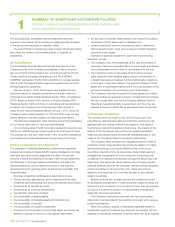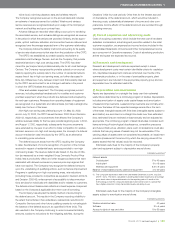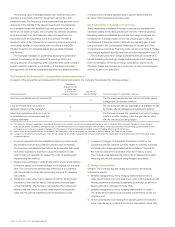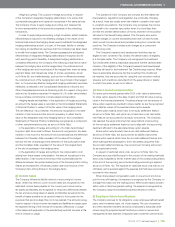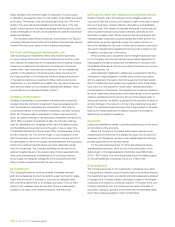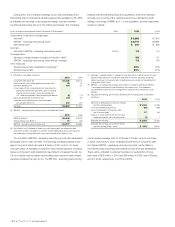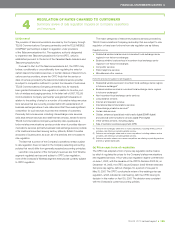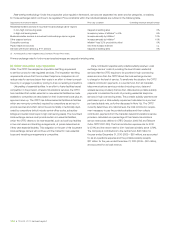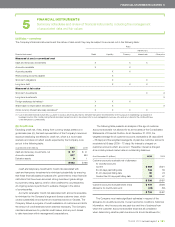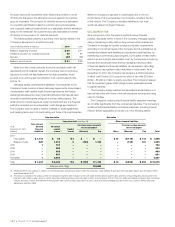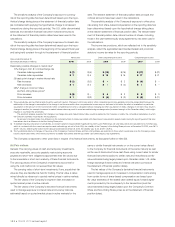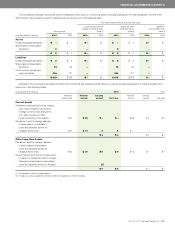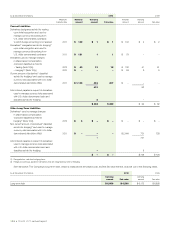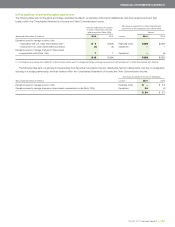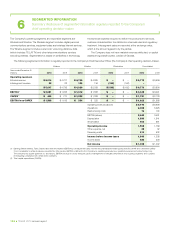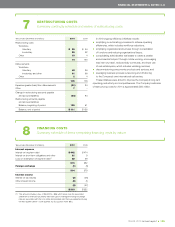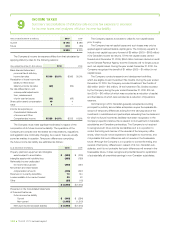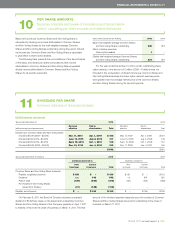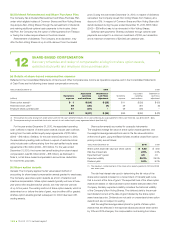Telus 2010 Annual Report Download - page 136
Download and view the complete annual report
Please find page 136 of the 2010 Telus annual report below. You can navigate through the pages in the report by either clicking on the pages listed below, or by using the keyword search tool below to find specific information within the annual report.
132 . TELUS 2010 annual report
While the Company is exposed to credit losses due to the non-
performance of its counterparties, the Company considers the risk
of this remote. The Company’s derivative liabilities do not have
credit-risk-related contingent features.
(c) Liquidity risk
As a component of the Company’s capital structure financial
policies, discussed further in Note 3, the Company manages liquidity
risk by maintaining a daily cash pooling process which enables the
Company to manage its liquidity surplus and liquidity requirements
according to the actual needs of the Company and its subsidiaries, by
maintaining bilateral bank facilities and syndicated credit facilities, by
maintaining a commercial paper program, by the sales of trade receiv-
ables to an arm’s-length securitization trust, by continuously monitoring
forecast and actual cash flows and by managing maturity profiles
of financial assets and financial liabilities. As disclosed in Note 18(g),
the Company has significant debt maturities in future years. As at
December 31, 2010, the Company has access to a shelf prospectus,
in effect until October 2011, pursuant to which it can offer $2 billion
(2009 – $3 billion) of debt or equity securities. The Company believes
that its investment grade credit ratings provide reasonable access
to capital markets.
The Company closely matches the derivative financial liability con-
tractual maturities with those of the risk exposures that they are being
used to manage.
The Company’s undiscounted financial liability expected maturities
do not differ significantly from the contractual maturities. The Company’s
undiscounted financial liability contractual maturities, including interest
thereon (where applicable), are as set out in the following tables:
the same factors are considered when determining whether to write
off amounts charged to the allowance account against the customer
account receivable. The provision for doubtful accounts is calculated
on a specific-identification basis for customer accounts receivable
over a specific balance threshold and on a statistically derived allowance
basis for the remainder. No customer accounts receivable are written
off directly to the provision for doubtful accounts.
The following table presents a summary of the activity related to the
Company’s allowance for doubtful accounts.
Years ended December 31 (millions) 2010 2009
Balance, beginning of period $ß59 $ß77
Additions (provision for doubtful accounts) 49 80
Net use (67) (98)
Balance, end of period $ß41 $ß59
Aside from the normal customer accounts receivable credit risk
associated with its retained interest, the Company has no continuing
exposure to credit risk associated with its trade receivables which
are sold to an arm’s-length securitization trust, as discussed further
in Note 14.
Derivative assets (and derivative liabilities): Counterparties to the
Company’s cross currency interest rate swap agreements, share-based
compensation cash-settled equity forward agreements and foreign
exchange derivatives are major financial institutions that have all been
accorded investment grade ratings by a primary rating agency. The
dollar amount of credit exposure under contracts with any one financial
institution is limited and counterparties’ credit ratings are monitored.
The Company does not give or receive collateral on swap agreements
and hedging items due to its credit rating and those of its counterparties.
Non-derivative Derivative
Non-interest
Long-term debt (see Note 18) Other financial liabilities
As at bearing All except Currency swaps amounts Currency swaps amounts
December 31, 2010 financial capital Capital to be exchanged(2) to be exchanged
(millions) liabilities leases(1)(2) leases (Receive) Pay Other (Receive) Pay Total
2 011
First quarter $ß1,173 $ 58 $ß3 $ – $ – $ß13 $ß(116) $ß118 $ß 1,249
Balance of year 229 1,013 5 (766) 1,183 – (190) 191 1,665
2012 1 701 – – – – – – 702
2013 – 583 – – – – – – 583
2014 – 958 – – – – – – 958
2015 – 851 – – – – – – 851
Thereafter 1 4,266 – – – – – – 4,267
To t a l $ß1,404 $ß8,430 $ß8 $ß(766) $ß1,183 $ß13 $ß(306) $ß309 $ß10,275
Total (see Note 18(g)) $ß8,855
(1) Interest payment cash outflows in respect of commercial paper and amounts drawn under the Company’s credit facilities (if any) have been calculated based upon the rates in effect
as at December 31, 2010.
(2) The amounts included in the undiscounted non-derivative long-term debt in respect of the U.S. dollar denominated long-term debt, and the corresponding amounts included in the
long-term debt currency swaps receive column, have been determined based upon the rates in effect as at December 31, 2010. The U.S. dollar denominated long-term debt contractual
maturity amounts, in effect, are reflected in the long-term debt currency swaps pay column as gross cash flows are exchanged pursuant to the cross currency interest rate swap
agreements (see Note 18(b)).


